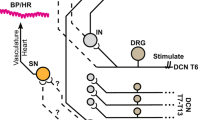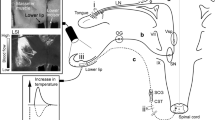Summary
In anesthetized rabbits immobilized with succinyl choline, the discharges of sympathetic efferents supplying cutaneous and visceral regions were simultaneously recorded. The effects of thermal stimulation of the hypothalamic region were tested on the basis of the integrated discharges. During hypothalamic heating cutaneous sympathetic activity decreased, corresponding to increased ear blood flow, while visceral sympathetic activity increased. During hypothalamic cooling there was, on the average, no significant change of regional sympathetic activity. However, in single experimental periods an increase of cutaneous and a decrease of visceral sympathetic activity was found.
The observed responses of regional sympathetic activity were compared with findings about regional cutaneous and intestinal blood flow under the same thermal stimulus and further with corresponding former investigations on regional blood flow and regional sympathetic activity during spinal thermal stimulation. It is suggested by this comparison that regional differentiation of sympathetic activity represents a specific thermoregulatory response of the vasomotor system mediated by the hypothalamic thermoregulatory center.
Similar content being viewed by others
References
Adair, E. R., Stitt, J. T.: Behavioral temperature regulation in the squirrel monkey: Effect of midbrain temperature displacements. Symposium international de thermorégulation comportementale. J. Physiol. (Paris)63, 191–194 (1971).
Andersson, B., Larsson, B.: Influence of local temperature changes in the preoptic area and rostral hypothalamus on the regulation of food and water intake. Acta physiol. scand.52, 75–89 (1961).
Brendel, W.: Die Bedeutung der Hirntemperatur für die Kältegegenregulation. III. Der Einfluß der Hirntemperatur auf den Kreislauf des Hundes. Pflügers Arch. ges. Physiol.270, 648–656 (1960).
Cabanac, M., Hardy, J. D.: Réponses unitaires et thermorégulatrices lors de réchauffements et refroidissements localisés de la région préoptique et du mésencéphale chez le lapin. J. Physiol. (Paris)61, 331–347 (1969).
—, Stolwijk, J. A. J., Hardy, J. D.: Effect of temperature and pyrogens on singleunit activity in the rabbit's brain stem. J. appl. Physiol.24, 645–652 (1968).
Djojosugito, A. M., Folkow, B., Kylstra, P. H., Lisander, B., Tuttle, R. S.: Differentiated interaction between the hypothalamic defence reaction and baroreceptor reflexes. I. Effects on heart rate and regional flow resistance. Acta physiol. scand.78, 376–385 (1970).
Eliasson, S., Folkow, B., Lindgren, P., Uvnäs, B.: Activation of sympathetic vasodilator nerves to the skeletal muscles in the cat by hypothalamic stimulation. Acta physiol. scand.23, 333–351 (1951).
Feigl, E. O.: Vasoconstriction resulting from diencephalic stimulation. Acta physiol. scand.60, 372–380 (1964).
Folkow, B., Rubinstein, E. H.: Cardiovascular effects of acute and chronic stimulations of the hypothalamic defence area in the rat. Acta physiol. scand.68, 48–57 (1966).
Freeman, W. J., Davis, D. D.: Effects on cats of conductive hypothalamic cooling. Amer. J. Physiol.197, 145–148 (1959).
Hammel, H. T., Hardy, J. D., Fusco, M. M.: Thermoregulatory responses to hypothalamic cooling in unanesthetized dogs. Amer. J. Physiol.198, 481–486 (1960).
Hardy, J. D.: Brain sensors of temperature. Brody Memorial Lecture VIII. Columbia: University of Missouri (1969).
—, Hellon, R. F., Sutherland, K.: Temperature-sensitive neurones in the dog's hypothalamus. J. Physiol. (Lond.)175, 242–253 (1964).
Jessen, C., Simon, E.: Spinal cord and hypothalamus as core sensors of temperature in the conscious dog. III. Identity of functions. Pflügers Arch.324, 217–226 (1971).
Kosaka, M., Simon, E., Thauer, R., Walther, O.-E.: Effect of thermal stimulation of spinal cord on respiratory and cortical activity. Amer. J. Physiol.217, 858 to 863 (1969).
Krüger, F. J., Kundt, H. W., Hensel, H., Brück, K.: Das Verhalten der Hautdurchblutung bei Hypothalamuskühlung an der wachen Katze. Pflügers Arch. ges. Physiol.269, 240–247 (1959).
Kullmann, R., Schönung, W., Simon, E.: Antagonistic changes of blood flow and sympathetic activity in different vascular beds following central thermal stimulation. I. Blood flow in skin, muscle and intestine during spinal cord heating and cooling in anesthetized dogs. Pflügers Arch.319, 146–161 (1970).
Lisander, B.: Factors influencing the autonomic component of the defence reaction. Acta physiol. scand.78, Suppl. 351, 1–42 (1970).
Monnier, M., Gangloff, H.: Atlas for stereotaxic brain research on the conscious rabbit. Amsterdam: Elsevier 1961.
Nakayama, T., Hardy, J. D.: Unit responses in the rabbit's brain stem to changes in brain and cutaneous temperature. J. appl. Physiol.27, 848–857 (1969).
Rautenberg, W., Simon, E., Thauer, R.: Die Bedeutung der Kerntemperatur für die chemische Temperaturregulation beim Hund in leichter Narkose. II. Isolierte Senkung der Hirntemperatur. Pflügers Arch. ges. Physiol.278, 350–360 (1963).
Schönung, W., Wagner, H., Jessen, C., Simon, E.: Differentiation of cutaneous and intestinal blood flow during hypothalamic heating and cooling in anesthetized dogs. Pflügers Arch.328, 145–153 (1971).
Simon, E., Iriki, M.: Ascending neurons of the spinal cord activated by cold. Experientia (Basel)26, 620–622 (1970).
Ström, G.: Influence of local thermal stimulation of the hypothalamus of the cat on cutaneous blood flow and respiratory rate. Acta physiol. scand.20, Suppl. 70, 47–76 (1950).
Walther, O.-E., Iriki, M., Simon, E.: Antagonistic changes of blood flow and sympathetic activity in different vascular beds following central thermal stimulation. II. Cutaneous and visceral sympathetic activity during spinal cord heating and cooling in anesthetized rabbits and cats. Pflügers Arch.319, 162–184 (1970).
Wünnenberg, W., Brück, K.: Single unit activity evoked by thermal stimulation of the cervical spinal cord in the guinea-pig. Nature (Lond.)218, 1266–1269 (1968).
——: Studies on the ascending pathways from the thermosensitive region of the spinal cord. Pflügers Arch.321, 233–241 (1970).
Author information
Authors and Affiliations
Rights and permissions
About this article
Cite this article
Iriki, M., Riedel, W. & Simon, E. Regional differentiation of sympathetic activity during hypothalamic heating and cooling in anesthetized rabbits. Pflugers Arch. 328, 320–331 (1971). https://doi.org/10.1007/BF00586834
Received:
Issue Date:
DOI: https://doi.org/10.1007/BF00586834




